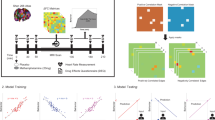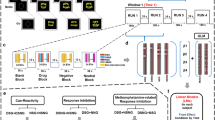Abstract
Drug cues, or conditioned responses to stimuli paired with drugs, are widely believed to promote drug use. The acquisition of these conditioned responses has been well characterized in laboratory animals: neutral stimuli paired with drugs elicit conditioned responses resembling the motivational and incentive properties of the drug itself. However, few studies have examined acquisition of conditioning, or the nature of the conditioned response, in humans. In this study, we used fMRI to examine neural responses to stimuli that had been paired with methamphetamine or placebo in healthy young adults. Participants first underwent four conditioning sessions in which visual-auditory stimuli were paired with either methamphetamine (20 mg, oral) or placebo. Then on a drug-free test day, the stimuli were presented during an fMRI scan to assess neural responses to the stimuli. We hypothesized that the stimuli would elicit drug-like brain activity, especially in regions related to reward. Instead, we found that the methamphetamine-paired stimuli, compared to placebo-paired stimuli, produced greater activation in regions related to visual and auditory processing, consistent with the drug’s unconditioned effects on sensory processing. This is the first study to demonstrate conditioned neural responses to drug-paired stimuli after just two pairings of methamphetamine in healthy adults. The study also illustrates that conditioned responses may develop to unexpected components of the drug’s effects.
Similar content being viewed by others
Log in or create a free account to read this content
Gain free access to this article, as well as selected content from this journal and more on nature.com
or
References
Berridge KC, Robinson TE. Liking, wanting, and the incentive-sensitization theory of addiction. Am Psychol. 2016;71:670–9.
Perry CJ, Zbukvic I, Kim JH, Lawrence AJ. Role of cues and contexts on drug-seeking behaviour. Br J Pharmacol. 2014;171:4636–72.
Robinson TE, Berridge KC. The neural basis of drug craving: an incentive-sensitization theory of addiction. Brain Res Rev. 1993;18:247–91.
Stewart J, de Wit H, Eikelboom R. Role of unconditioned and conditioned drug effects in the self-administration of opiates and stimulants. Psychol Rev. 1984;91:251–68.
Arroyo M, Markou A, Robbins TW, Everitt BJ. Acquisition, maintenance and reinstatement of intravenous cocaine self-administration under a second-order schedule of reinforcement in rats: effects of conditioned cues and continuous access to cocaine. Psychopharmacology. 1998;140:331–44.
Crombag HS, Bossert JM, Koya E, Shaham Y. Context-induced relapse to drug seeking: a review. Philos Trans R Soc B Biol Sci. 2008;363:3233–43.
Palmatier MI, Liu X, Matteson GL, Donny EC, Caggiula AR, Sved AF. Conditioned reinforcement in rats established with self-administered nicotine and enhanced by noncontingent nicotine. Psychopharmacology. 2007;195:235–43.
Ehrman RN, Robbins SJ, Childress AR, O’Brien CP. Conditioned responses to cocaine-related stimuli in cocaine abuse patients. Psychopharmacology. 1992;107:523–9.
Monti PM, Binkoff JA, Abrams DB, Zwick WR, Nirenberg TD, Liepman MR. Reactivity of alcoholics and nonalcoholics to drinking cues. J Abnorm. 1987;96:122–6.
Bedi G, Preston KL, Epstein DH, Heishman SJ, Marrone GFm Shaham Y, et al. Incubation of cue-induced cigarette craving during abstinence in human smokers. Biol Psychiatry. 2011;69:708–11.
Meil WM, See RE. Conditioned cued recovery of responding following prolonged withdrawal from self-administered cocaine in rats: an animal model of relapse. Behav Pharmacol. 1996;7:754–63.
O’Brien CP, Childress AR, McLellan AT, Ehrman R. Classical conditioning in drug-dependent humans. Ann N Y Acad Sci. 1992;654:400–15.
Robbins SJ, Ehrman RN, Childress AR, O’Brien CP. Comparing levels of cocaine cue reactivity in male and female outpatients. Drug Alcohol Depend. 1999;53:223–30.
Waters AJ, Carter BL, Robinson JD, Wetter DW, Lam CY, Kerst W, et al. Attentional bias is associated with incentive-related physiological and subjective measures. Exp Clin Psychopharm. 2009;17:247–57.
Mayo LM, de Wit H. Acquisition of responses to a methamphetamine-associated cue in healthy humans: self-report, behavioral, and psychophysiological measures. Neuropsychopharmacology. 2015;40:1734–41.
Mayo LM, de Wit H. Acquisition of conditioned responses to a novel alcohol-paired cue in social drinkers. J Stud Alcohol Drugs. 2016;77:317–26.
Mayo LM, Fraser D, Childs E, Momenan R, Hommer DW, de Wit H, et al. Conditioned preference to a methamphetamine-associated contextual cue in humans. Neuropsychopharmacology. 2013;38:921–9.
Childs E, de Wit H. Alcohol-induced place conditioning in moderate social drinkers. Addiction. 2016;111:2157–65.
Field M, Cox W. Attentional bias in addictive behaviors: a review of its development, causes, and consequences. Drug Alcohol Depend. 2008;97:1–20.
Boileau I, Dagher A, Leyton M, Welfeld K, Booji L, Diksic M, et al. Conditioned dopamine release in humans: a positron emission tomography [11C]raclopride study with amphetamine. J Neurosci. 2007;27:3998–4003.
Kareken DA, Grahame N, Dzemidzic M, Walker MJ, Lehigh CA, O’Connor SJ. fMRI of the brain’s response to stimuli experimentally paired with alcohol intoxication. Psychopharmacology. 2012;220:787–97.
Cavallo JS, Mayo LM, de Wit H. Acquisition of conditioning between methamphetamine and cues in healthy humans. PLoS ONE. 2016;11:e0161541.
Martin-Soelch C, Linthicum J, Ernst M. Appetitive conditioning: neural bases and implications for psychopathology. Neurosci Biobehav Rev. 2007;31:426–40.
Pavlov, IP. Conditioned reflexes: an investigation of the physiological activity of the cerebral cortex. New York, NY: Dover Publications; 1927. .
Breiter HC, Gollub RL, Weisskoff RM, Kennedy DN, Makris N, Berke JD, et al. Acute effects of cocaine on human brain activity and emotion. Neuron. 1997;19:591–611.
Volkow ND, Wang G, Fowler JS, Logan J, Gerasimov M, Maynard L, et al. Therapeutic doses of oral methylphenidate significantly increase extracellular dopamine in the human brain. J Neurosci. 2001;21:RC121.
Jasinska AJ, Stein EA, Kaiser J, Naumer MJ, Yalachkov Y. Factors modulating neural reactivity to drug cues in addiction: a survey of human neuroimaging studies. Neurosci Biobehav Rev. 2014;38:1–16.
Yalachkov Y, Kaiser J, Naumer MJ. Functional neuroimaging studies in addiction: multisensory drug stimuli and neural cue reactivity. Neurosci Biobehav Rev. 2012;36:825–35.
Johanson CE, Uhlenhuth EH. Drug preference and mood in humans: diazepam. Psychopharmacology. 1980;71:269–73.
Morean ME, de Wit H, King AC, Sofuoglu M, Rueger SY, O’Malley SS. The drug effects questionnaire: psychometric support across three drug types. Psychopharmacology. 2013;227:177–92.
McNair, D, Lorr, M. & Droppleman, L. Profile of mood states. San Diego, CA: Educational and Industrial Testing Service; 1971. .
Wardle MC, Garner MJ, Munafó MR, de Wit H. Amphetamine as a social drug: effects of d-amphetamine on social processing and behavior. Psychopharmacology. 2012;223:199–210.
Cox RW. AFNI: software for analysis and visualization of functional magnetic resonance neuroimages. Comput Biomed Res. 1996;29:162–73.
Tziortzi AC, Haber SN, Searle GE, Tsoumpas C, Long CJ, Shotbolt P, et al. Connectivity-based functional analysis of dopamine release in the striatum using diffusion-weighted MRI and positron emission tomography. Cereb Cortex. 2014;24:1165–77.
Eklund A, Nichols TE, Knutsson H. Cluster failure: why fMRI inferences for spatial extent have inflated false-positive rates. Proc Natl Acad Sci. 2016;113:7900–05.
Söderpalm A, Nikolayev L, de Wit H. Effects of stress on responses to methamphetamine in humans. Psychopharmacology. 2003;27:1270–7.
Wachtel SR, Ortengren A, de Wit H. The effects of acute haloperidol or risperidone on subjective responses to methamphetamine in healthy volunteers. Drug Alcohol Depend. 2002;68:23–33.
Uftring SJ, Wachtel SR, Chu D, McCandless C, Levin DN, de Wit H. An fMRI study of the effect of amphetamine on brain activity. Neuropsychopharmacology. 2001;25:925–35.
Eikelboom R, Stewart J. Conditioning of drug-induced physiological responses. Psychol Rev. 1982;89:507–28.
Heal DJ, Smith SL, Gosden J, Nutt DJ. Amphetamine, past and present – a pharmacological and clinical perspective. J Psychopharmacol. 2013;27:479–96.
Moeller SJ, Honorio J, Tomasi D, Parvaz MA, Woicik PA, Volkow ND, et al. Methylphenidate enhances executive function and optimizes prefrontal function in both health and cocaine addiction. Cereb Cortex. 2014;24:643–53.
Nestler, EJ, Hyman, SE. & Malenka, RC. Chapter 13: Higher cognitive function and behavioral control. 2nd ed. In: Molecular neuropharmacology: a foundation for clinical neuroscience. New York, NY: McGraw-Hill Medical; 2009. P 313–34..
Tomasi D, Volkow N, Wang G, Wang R, Telang F, Caparelli E, et al. Methylphenidate enhances brain activation and deactivation responses to visual attention and working memory tasks in healthy controls. NeuroImage. 2011;54:3101–10.
Rheker J, Winkler A, Doering BK, Rief W. Learning to experience side effects after antidepressant intake – results from a randomized, controlled, double-blind study. Psychopharmacology. 2017;234:329–38.
Koob GF, Volkow ND. Neurobiology of addiction: a neurocircuitry analysis. Lancet Psychiatry. 2016;3:760–73.
Ghaziri J, Tucholka A, Girard G, Houde JC, Boucher O, Gilbert G, et al. The corticocortical structural connectivity of the human insula. Cereb Cortex. 2017;27:1216–28.
Cavallo JS, Ruiz NA, de Wit H. Extinction of conditioned responses to methamphetamine-associated stimuli in healthy humans. Psychopharmacology. 2016;233:2489–502.
Acknowledgements
This research was supported by DA037011, and benefitted from S10OD018448 awarded to the University of Chicago MRI Research Center. Kathryne Van Hedger is currently supported by NIMH training grant T32MH020065. Dr. de Wit has received support unrelated to this study from the following sources: Consulting fees from Marinius and Jazz Pharmaceuticals; gift of a study drug from Indivior; and support for a research study from Insys Therapeutics.
Author information
Authors and Affiliations
Corresponding author
Ethics declarations
Conflict of interest
The authors declare that they have no conflict of interest.
Rights and permissions
About this article
Cite this article
Van Hedger, K., Keedy, S.K., Mayo, L.M. et al. Neural responses to cues paired with methamphetamine in healthy volunteers. Neuropsychopharmacol 43, 1732–1737 (2018). https://doi.org/10.1038/s41386-017-0005-5
Received:
Accepted:
Published:
Issue date:
DOI: https://doi.org/10.1038/s41386-017-0005-5
This article is cited by
-
MicroRNA-31-3p/RhoA signaling in the dorsal hippocampus modulates methamphetamine-induced conditioned place preference in mice
Psychopharmacology (2021)
-
Effects of methamphetamine on neural responses to visual stimuli
Psychopharmacology (2019)
-
Pairing neutral cues with alcohol intoxication: new findings in executive and attention networks
Psychopharmacology (2018)



